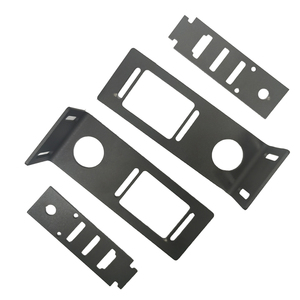
All categories
Featured selections
Trade Assurance
Buyer Central
Help Center
Get the app
Become a supplier

(298047 products available)














































Laser cutting machines have a variety of applications across multiple fields. Their precision cutting, engraving, and marking abilities make lasers an integral tool for various materials from metal to glass and even fabrics. Here are the popular types of laser cutting methods:
Metal remains one of the most popular material for laser cutting. Co2 laser cutters, in particular, are very effective for cutting metal since they generate high-density beams that can cut through thick metal layers. Usually, these co2 machines utilize either high pressure oxygen or nitrogen in order to assist in cutting.
Laser cutting produces accurate and detailed custom signage. It enables creation of signage from a range of materials including wood, acrylic, and metal. The precision of the cuts improve the visual quality of the signs, making them eye-catching features for residential and commercial properties.
Just like any other business process, laser cutting offers precision, speed, and efficiency ideal for mass production in the industrial sector. Common applications involve creating components, parts, or materials used in industries such as automotive, aerospace, and electronics.
Laser cutting provides a non-destructive method of obtaining a key impression from a lock, making it a viable option for picking. The technique employs a transparent cutting tool that has to be placed on the lock. The tool's edge will then outline the key's teeth and grooves, thus providing a precise template needed for key duplication.
A fiber laser cutting machine is able to cut glass and crystal materials easily and effectively. The accuracy of the fiber laser allows for detailed engravings and intricate cuts that enhance the aesthetic value of glass products. Common applications include engraved awards, personalized gifts, and decorative glass elements.
High precision laser cutting is suitable for fabric materials in the garment industry. Laser cutting machines can cut fabrics for clothes design and also for other items like upholstery or home decorations. Fiber and CO2 lasers cut through different fabric types including cotton, leather, and synthetic materials.
Laser cutting machines offer high precision and versatility, thus making them ideal for many industrial use across different fields. They are utilized to cut, engrave, and mark materials with greater accuracy than traditional methods. The following are the most common industrial application of laser cutting:
Laser cutting provides high precision and control, required for the complex shapes and tight tolerances in aerospace components. That is why there are aerospace applications that utilize laser cutting to shape and prototype parts from lightweight alloys and composite materials.
The automotive industry uses laser cutting to produce various parts and components such as brackets, trim pieces, and body panels. The accuracy of laser cutting ensures that parts fit perfectly, which will enhance the overall performance and aesthetics of the vehicle. Also, laser cutting minimizes wastage since it only requires a small amount of material to achieve the required results.
Laser cutting is widely used in the electronics industry to manufacture pcbs (printed circuit boards) and other components. Laser cutting machines offer the required precision to cut the thin materials used in electronics without damaging them.
Laser cutting makes critical contributions in medical fields with its applications in the production of implants, surgical instruments, and diagnostic equipment. Of particular interest, laser cutting's precision is able to make intricate designs that are vital for medical devices to work properly, thus making them safer for the end user.
Sheet metal remains one of the most popular material in laser cutting. Industries that use lasers to cut and shape metal sheets for a variety of applications ranging from machinery parts to construction elements. Laser cutting offers the ability to create complex shapes and designs which improve the performance and efficiency of final products.
Laser cutting also has applications in consumer goods such as precise cuts in the production of items like eyewear, jewelry, and watches. In the fast-paced consumer goods industry, laser cutting ensures that repetitive production of high-quality products is possible.
Understanding the technical specifications of laser cutting machines provides insight into their capabilities and performance.
Installation of a laser cutting machine involves several key steps to ensure proper setup and operation. Here are the general steps to install a laser cutting machine:
Users should learn the basics of operating a laser cutting machine to utilize it properly and safely.
To ensure longevity and optimal performance, users should adhere to routine maintenance practices and address repairs as required on their machines.
Laser cutting is a highly efficient and precise process, but quality and safety considerations are vital to ensure optimal results and a secure working environment. Here are some key quality and safety considerations for laser cutting:
Material Thickness
Every laser cutting machine has a threshold in terms of material thickness it can handle. Going beyond a machine's capability by using excessively thick material may result in cut edges that are rough and stacked with charred residue. On the other hand, using very thin material isn't a challenge for the laser. It may cause distortion to set in as the laser beam cuts through at extremely high concentration.
Manufacturers mostly have laser cutting machines that range in power from 500 to 6000 watts. These machines are ideal for both thick and thin materials as they provide flexibility with interchangeable laser heads of different sizes.
Material Type
Laser cutting is effective to a certain degree when it comes to non-metal materials like acrylic and wood. However, cutting through metal materials requires much stronger laser cutting machines, such as fiber lasers. While CO2 lasers can penetrate metal to a sizable extent, fiber lasers accomplish the task far more effectively and efficiently.
Edge Finish
The quality of laser cutting edge finish hugely depends on the type of laser that is applied to the material. For instance, when a material is cut using a fiber laser, it attains the sharpest edge. This is compared with the edge attained by CO2 lasers, which are significantly not as fine. Whenever a CO2 laser is used on metals, the edge typically ends up jagged.
Speed Settings
The optimal cutting speed is crucially dependent on the material type and thickness being used. A too-slow cutting speed will generate excessive heat, which will cause the material to melt or warp. Contrarily, a too-fast speed will not allow the laser sufficient time to make an effective cut.
In order to mitigate risks associated with laser cutting, users must understand and observe the following safety measures:
Protective Equipment
Proper eye and skin protection is useful during laser cutting to guard against harmful laser radiation and potential flying debris. Similarly, respirators or masks with filters come in handy when cutting materials that produce toxic fumes.
Machine Safety Features
All machine safety measures are meant to be employed. They include emergency shut-offs, interlocks, and protective covers. These measures function to lower the risk of accidents by preventing unauthorized access to the laser beam.
Material Selection
The dangerous effects of cutting materials that emit harmful vapors such as PVC are well documented. Therefore, users should avoid using such materials and settle for safer alternatives instead. However, if they must use them, users should ensure they work in well-ventilated areas, as well as using fume extractors.
Electrical Safety
To minimize the risk of electrical accidents, users should avoid any personal interaction with the electrical components of the laser cutting machine. Moreover, any machine requiring electrical connection should be set up by a qualified electrician instead of an amateur.
A1.Laser cutting works well on metals like steel, aluminum, and brass, especially with fiber or CO2 lasers. Non-metals such as wood, acrylic, and fabric are also easily cut. Materials like glass and paper can be cut with precision using laser technology. Custom-made laser cutting machines can handle specific materials for unique requirements.
A2. Lasers cut with more precision, informing cleaner edges and reducing waste. They handle complex designs effortlessly compared to traditional tools, which may require more force and time. Though initial costs are higher, lasers prove efficient for mass production with minimal need for post-cut adjustments.
A3.A CO2 laser provides smooth and precise cuts on acrylic, ensuring clear edges without damage. It efficiently handles detailed designs, making it ideal for custom acrylic displays. Quick cutting speeds enhance productivity by reducing time taken for each piece. This makes it an ideal choice for large-scale production runs.
A4. Regular lens cleaning and alignment checks are necessary. The cutting bed should be cleaned of any debris, and the machine should be inspected for wear. Software updates should be performed, and users should refer to the user manual for specific maintenance requirements. Professional servicing is required for complicated internal components.
A5. Proper eye and skin protection should be used, along with machine safety features like emergency shut-offs. A qualified electrician should perform electrical installations. Materials that emit harmful fumes should be cut in well-ventilated areas. Users should adhere to manufacturer guidelines for safe operation.